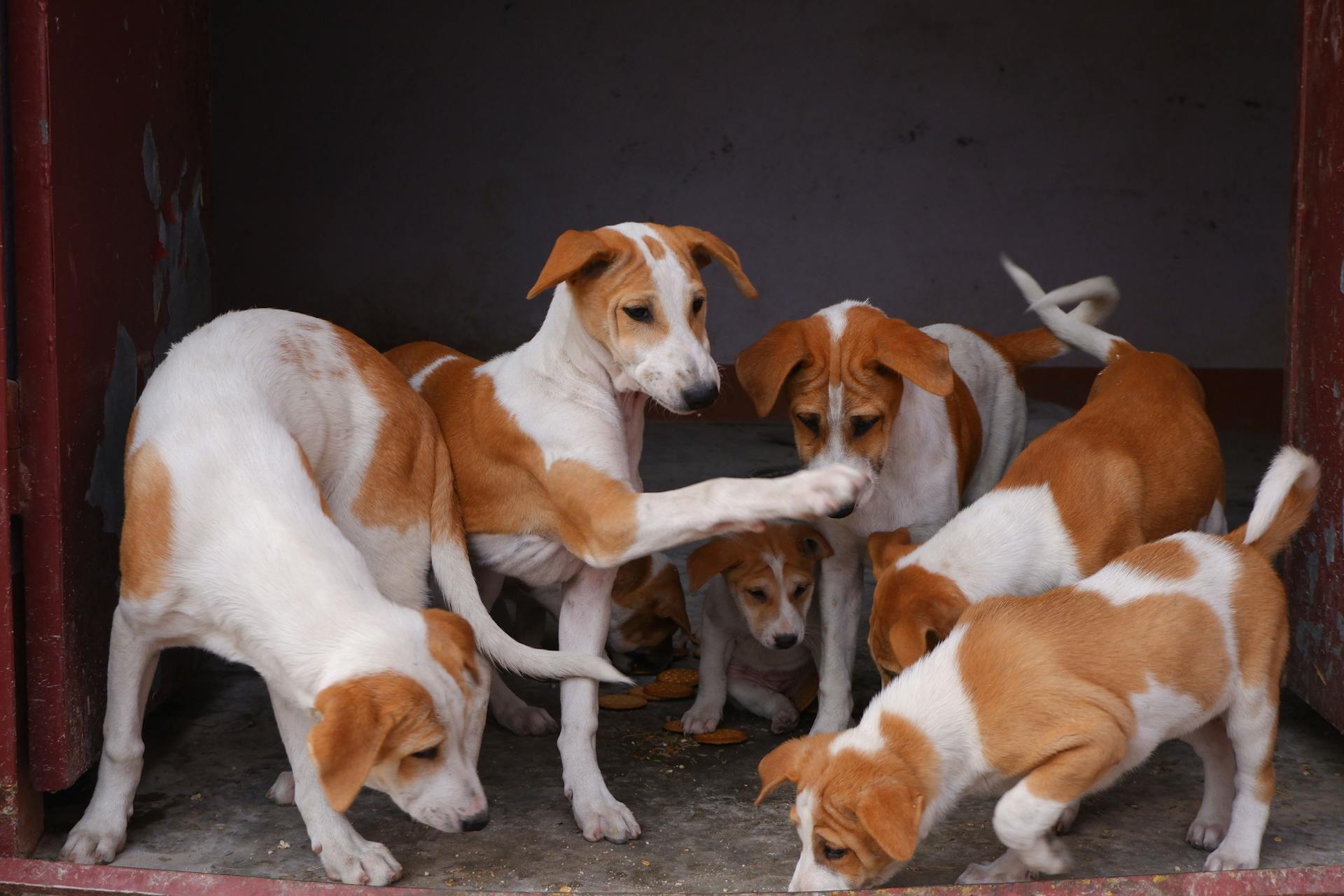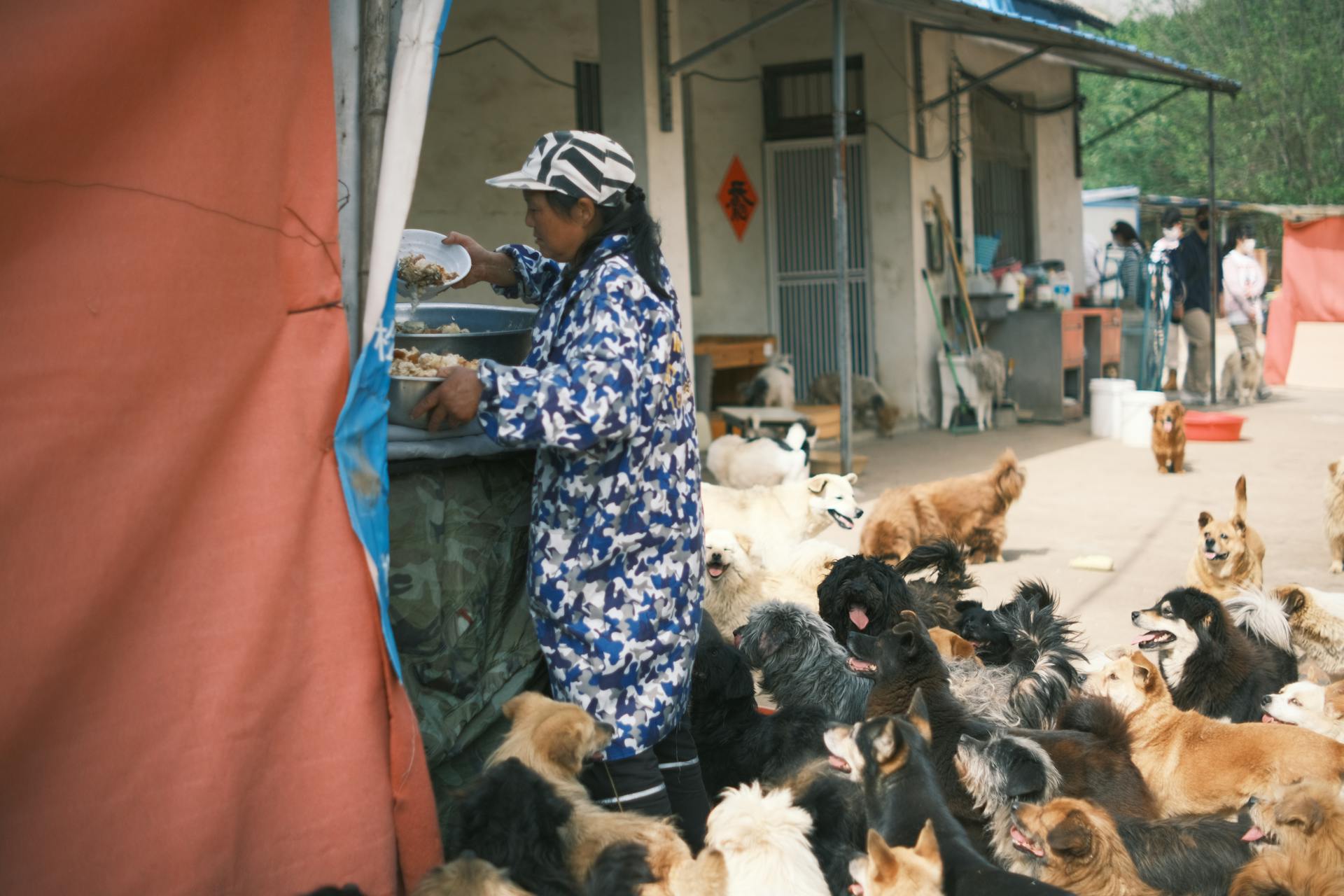
Resource guarding in dogs is a complex behavior that can be triggered by various factors. One of the primary causes is a dog's natural instinct to defend its food, territory, and family.
Some breeds, such as terriers and guard dogs, are more prone to resource guarding due to their original purpose as hunting and guarding animals. This instinctual behavior can be intensified by a dog's environment and upbringing.
Insecure or fearful dogs may also be more likely to exhibit resource guarding due to their heightened anxiety levels. This can be a result of past traumas or lack of socialization.
A dog's history of food deprivation or scarcity can also contribute to resource guarding, as they may become overly possessive of their food.
Causes and Prevention
Resource guarding in dogs is a natural behavior that can be triggered by various factors. Dogs may feel threatened or insecure due to poor genetics or breeding, lack of early socialization, or harsh training methods. This can lead to resource guarding as a way to cope with their environment.
Some common triggers for resource guarding include field-line gun dogs, such as spaniels and retrievers, who may be more prone to this behavior. Owners who repeatedly take items away or put their hand in the dog's bowl from an early age can also inadvertently encourage resource guarding.
Here are some potential causes of resource guarding in dogs:
- Poor genetics/breeding and/or lack of early socialization
- A history of harsh training methods, especially when started at an early age
- Well-meaning owners have repeatedly taken items away or put their hand in the dog's bowl from an early age
- The dog has had limited resources in the past, such as a dog that came from a puppy mill or hoarding situation
Preventing resource guarding in puppies requires attention to their early socialization and training. By avoiding harsh methods and respecting their boundaries, you can help your puppy develop healthy habits and reduce the risk of resource guarding.
Why Dogs Guard
Dogs guard because they feel their valued items are at risk of being taken away. This natural survival behavior can manifest in various ways, such as stiffening up or staring intently at the person or animal in question.
Some dogs may resource guard due to poor genetics or breeding, lack of early socialization, or a history of harsh training methods. These factors can contribute to a dog's insecurity and inability to cope with changes in their environment.
Dogs may also resource guard due to limited resources in the past, such as coming from a puppy mill or hoarding situation. This can lead to a dog feeling the need to control the outcome of some aspect of their environment.
Common triggers for resource guarding include a dog's breed or mix, with field-line gun dogs like spaniels and retrievers being more prone to this behavior. Other triggers include changes in the environment, such as a new baby or visitor, or competition over limited resources.
Here are some common reasons why dogs resource guard:
- Feeling threatened or insecure
- Changes in the environment
- Competition over limited resources
- Feeling like a resource might be taken away arbitrarily
- Feeling the need to control the outcome of some aspect of the environment
Preventing Dog Theft
Preventing dog theft requires early training to prevent resource guarding from developing. Training your dog to not steal is crucial to prevent resource guarding.
You can start by desensitizing your dog to your presence around high-value items, such as food. This can be done by slowly tossing food in your dog's general direction while keeping a safe distance.

Tethering your dog to a heavy and durable object can help prevent them from running off with food. Stay at least 6 to 8 feet away from your dog and toss the food in their direction.
Approaching your dog's bowl without them feeling threatened or stressed is the ultimate goal. This can be achieved by slowly moving closer while tossing food in their direction.
Working with professional trainers can be helpful in dealing with resource guarding in dogs. They can provide tips and tricks to guide you through the process.
How to Stop It
Stopping resource guarding requires a gentle and understanding approach. It's essential to recognize that resource guarding is not about dominance, but rather about a dog's natural instinct to protect their valuables.
Ignoring or punishing a dog's initial warnings, such as stiffening up or staring intently, can escalate the behavior to more vocal protests like growling or snapping. This can quickly lead to biting, which is a serious issue that requires professional help.

To prevent resource guarding, it's crucial to avoid taking items away from your dog, especially from an early age. This can create a sense of insecurity and lead to guarding behavior. Instead, focus on teaching your dog to trust you and feel secure with you around their valuables.
Here are some common triggers for resource guarding:
- Field-line gun dogs, such as spaniels and retrievers, are more prone to resource guarding.
- Poor genetics, harsh training methods, and limited early socialization can contribute to resource guarding.
- Dogs that have had limited resources in the past, such as those from puppy mills or hoarding situations, may develop resource guarding behavior.
If you're introducing a new dog to your household and notice guarding issues, it's essential to address the behavior promptly. A professional animal behaviorist can help you develop a treatment plan to address the issue and ensure a smooth transition for all dogs in the household.
In some cases, resource guarding can become a serious issue, especially if babies or toddlers are present. If you notice any signs of aggressive behavior, it's crucial to seek professional help immediately.
Identifying and Understanding the Behavior
Resource guarding can start without warning, and it's essential to recognize the warning signs. Nicole Costanza, an AKC Canine Good Citizen Evaluator, notes that stiffening the body over an item is one of the first signs of resource guarding.
A hard stare, "whale eye", lifting the lips, low growling, and baring the teeth are all potential indicators. These behaviors are not specific to one breed, and any dog can be prone to resource guarding.
The environment a dog grows up in can play a significant role in whether they develop resource guarding issues. A dog from a breeder might exhibit resource guarding, but a shelter dog may not.
Frequently Asked Questions
Can dogs be trained out of resource guarding?
Yes, dogs can be trained out of resource guarding with the right behavior modification plans, such as counterconditioning and desensitization. With proper training, you can help your dog overcome this behavior and build a stronger, more trusting relationship.
Sources
- https://www.akc.org/expert-advice/training/resource-guarding-in-dogs/
- https://rsdtraining.com/so-you-say-your-dogs-a-resource-guarder/
- https://peachonaleash.com/resource-guarding-why-it-happens-and-how-to-stop/
- https://scholarlydog.com/2022/10/27/lets-talk-about-resource-guarding/
- https://demarinisdogtraining.com/resource-guarding-in-dogs/
Featured Images: pexels.com


